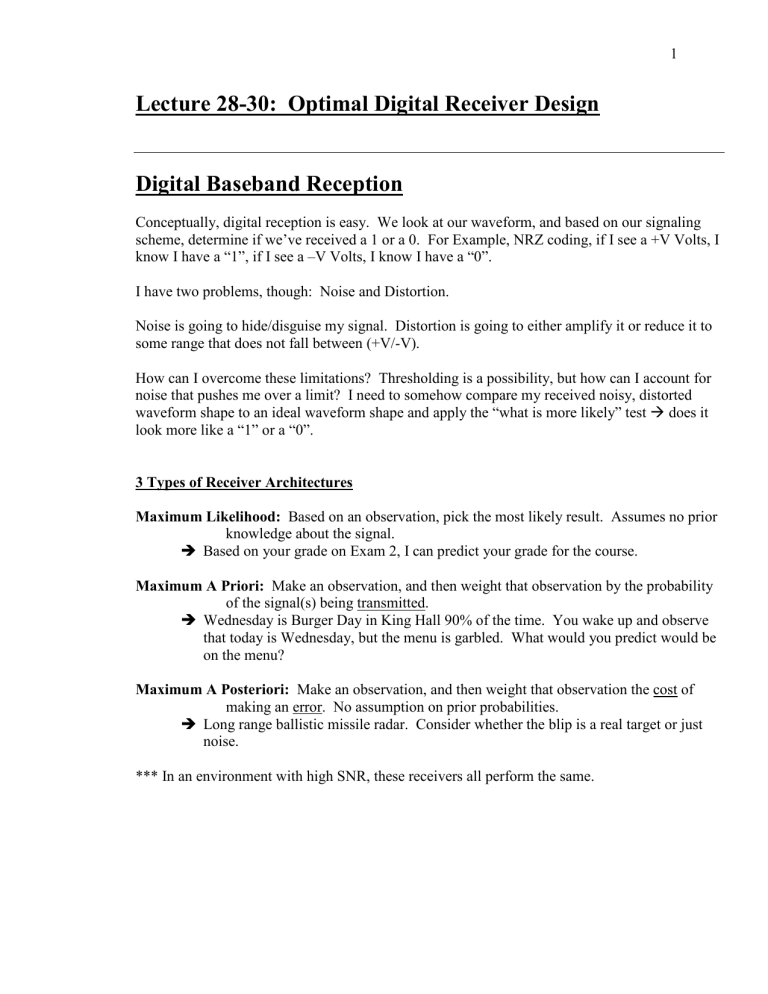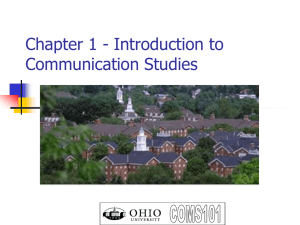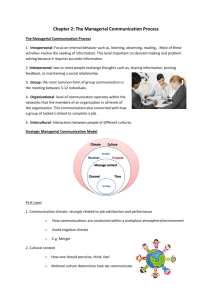Lecture 28-30: Optimal Digital Receiver Design Digital Baseband Reception
advertisement

1
Lecture 28-30: Optimal Digital Receiver Design
Digital Baseband Reception
Conceptually, digital reception is easy. We look at our waveform, and based on our signaling
scheme, determine if we’ve received a 1 or a 0. For Example, NRZ coding, if I see a +V Volts, I
know I have a “1”, if I see a –V Volts, I know I have a “0”.
I have two problems, though: Noise and Distortion.
Noise is going to hide/disguise my signal. Distortion is going to either amplify it or reduce it to
some range that does not fall between (+V/-V).
How can I overcome these limitations? Thresholding is a possibility, but how can I account for
noise that pushes me over a limit? I need to somehow compare my received noisy, distorted
waveform shape to an ideal waveform shape and apply the “what is more likely” test does it
look more like a “1” or a “0”.
3 Types of Receiver Architectures
Maximum Likelihood: Based on an observation, pick the most likely result. Assumes no prior
knowledge about the signal.
Based on your grade on Exam 2, I can predict your grade for the course.
Maximum A Priori: Make an observation, and then weight that observation by the probability
of the signal(s) being transmitted.
Wednesday is Burger Day in King Hall 90% of the time. You wake up and observe
that today is Wednesday, but the menu is garbled. What would you predict would be
on the menu?
Maximum A Posteriori: Make an observation, and then weight that observation the cost of
making an error. No assumption on prior probabilities.
Long range ballistic missile radar. Consider whether the blip is a real target or just
noise.
*** In an environment with high SNR, these receivers all perform the same.
2
The Digital Receiver Problem Statement
We transmit a binary signal s ( t ) ∈ {s0 ( t ) , s1 (t )} , where s ( t ) is nonzero only on [ 0, Tb ] (i.e., it’s
only defined for the bit time, a 0 or a 1).
Let the two signals be transmitted with probability:
=
p0 Pr
=
s0 ( t ) , p1 Pr s1 ( t )
The received signal is corrupted by noise: r=
(t ) s (t ) + n (t )
For a binary communication system, the Probability of Bit Error is given by:
P ( e ) = Pr [sˆ ≠ s ] = Pr sˆ ≠ s 0 s = s 0 + Pr sˆ ≠ s1 s = s1
Where Pr sˆ ≠ s 0 s = s 0 is the conditional probability of the receiver not deciding on si given
that si was transmitted.
To solve for that:
Pr sˆ ≠ s 0 s = s 0 = 1 − ∫ p ( r s 0 ) dr
R0
0
Pr sˆ ≠ s 0 s = s 0 = 1 −
∫
−∞
( r + V )2
1
exp −
dr
N
p N0
0
My Objective
Given r ( t ) , the receiver forms an estimate ŝ ( t ) of the signal s ( t ) with the goal of minimizing
the error probability:
=
Pe Pr sˆ ( t ) ≠ s ( t )
3
The Maximum Likelihood Receiver (i.e., a simple Threshold Receiver)
Consider first a non-Matched Filter detector (i.e., just a threshold detector). The signaling
scheme is baseband data transmission that uses bipolar line codes (+V for a binary 1 and –V for a
binary 0) and NRZ Signaling.
The Maximum Likelihood receiver observe the received voltage and pick the most likely
signal (s0 or s1).
At the receiver, we will have two voltages that follow Gausian PDFs. More formally, they
follow Conditional PDFs:
−
1
f y ( y | s0 ) =
2πs n2
−
1
f y ( y | s1 ) =
2πs
e
2
n
e
( y +V )2
2s n2
( y −V )2
2s n2
The first is the PDF of the Received Voltage GIVEN THAT signal s0 was transmitted.
The second is the PDF of the Received Voltage GIVEN THAT signal s1 was transmitted.
Note That: We have implicitly assumed that the two signals are equally probable.
What I want to do here is maximize the probability of choosing the correct signal.
Under the conditions that signals are equally probable, our decision threshold is 0V, and the error
probability is given by:
=
Pe Pr ( s0 ) ∫ f y ( y | s0 ) + Pr ( s1 ) ∫ f y ( y | s1 )
R1
R0
( 0.5) ∫ f y ( y | s0 ) + ( 0.5) ∫ f y ( y | s1 )
=
Pe
R1
Pe =
R0
∫ f (y|s )
y
0
R1
Pe = ∫
∞
0
−
1
2πs
2
n
V2
Pe = Q
N0 fm
Where:
e
( y +V )2
2s n2
dy
=
Q (u )
∞
∫
u
1
exp ( − x 2 2 ) dx
2p
4
Assume:
Both signals have equal energy and equal time duration, and the baseband data
has NRZ Signaling.
In that case, the two energies are the same, and f=
R=
m
b
1
Tb
V2
Eb 1
Eb
Thus: Pe Q=
=
Q
Q =
N0 fm
T
N
f
N
b
m
0
0
But the ML Receiver is really the worst of the three (we can prove that mathematically, but it’s
easy to think about it empirically).
What I really want to do is find a way to extract the signal from the noise. It’s similar to having
a conversation with someone in a noisy room. Your brain has the ability to extract someone’s
voice from the rest of the crowd.
5
The Correlation Receiver
Consider this: Create a template waveform for a logic 1 and logic 0. Take the incoming bit and
correlate it with the template signal: multiply and integrate.
Logic 1 Template
Logic 0 Template
+V
+V
0
0
-V
-V
What happens on the output of the integrator (abbreviated derivation in Appendix C):
∫ ( s ( t ) + n ( t ) )s ( t ) dt
=
sˆ (T ) ∫ s ( t ) dt + ∫ s ( t ) n ( t ) dt
=
sˆo (T )
T
0
T
o
T
2
0
0
For a digital signal over one bit period, we know that the value of the signal is going to be
constant, thus:
=
sˆo (T )
∫ (V )
T
0
2
dt + ∫ (V ) n ( t ) dt
T
0
sˆo (=
T ) V T + Random Number
2
Notice: The first term is just a number which will be proportional to the amplitude of our digital
bit. The second term is a random “add on” which represents the time integrated noise added to
the signal.
We can make the same argument for a binary 0 (-V) volts, with a similar correlator. So we can
put both of these together in the following manner:
6
Block Diagram (Figure 2.66c)
To illustrate how this works, consider the following four cases:
Received Bit
+V Correlator Output
-V Correlator Output
1
0
V2T
-V2T
-V2T
V2T
So we could conclude that all we need to do is compare the two correlator outputs and always
pick the largest. We can further simplify by only correlating with a single template (2.66d):
Received Bit
+V Correlator Output
1
0
V2T
-V2T
What we observe is that our decision threshold is now 0. Caution: That assumes my bits are
equally probable and that errors have equal cost.
Note: The simplicity of this system. I just correlate with a template waveform and compare the
result to zero. This is really easy to do with any microprocessor, DSP, or digital hardware.
The name of this receiver architecture is the Matched Filter Receiver, and it shows up
everywhere in the world of communications, because it is the optimum receiver structure for
AWGN channels.
7
Setting the Detector Threshold
Now, we have a little bit of a problem. The input to our decision circuit is a random variable.
Instead of just a number, we have a deterministic part (the V2T) and a random part (the random
noise).
In general, we assume that noise added to our system is AWGN, so that it follows a Gaussian
PDF. That means that the input to our detector is a Gaussian RV (which is nice). What happens
now is that the input to my detector can be modeled as a pair of PDF’s (see powerpoint slide).
In order to make a determination on which bit I choose, I have to know two things:
•
•
The probability of sending each bit
The cost of making an error
Under the conditions where the two bits are equally probable and errors are equal cost (which is
what happens in digital communication systems), the decision threshold is exactly in between.
Does this prevent errors? No, but it does minimize the total cost of making errors.
I can easily expand this argument to multi-level signaling. In that case, I’m going to be looking
at signal regions. Notice that as soon as I go to multi-level signaling on a single axis, my region
sizes are no longer equal.
8
The Maximum A Posteriori Receiver (Matched Filter Receiver_
Consider this: Create a template waveform for a logic 1 and logic 0. Take the incoming bit and
correlate it with the template signal: multiply and integrate.
Logic 1 Template
Logic 0 Template
+V
+V
0
0
-V
-V
What happens on the output of the integrator:
∫ ( s ( t ) + n ( t ) )s ( t ) dt
=
sˆ (T ) ∫ s ( t ) dt + ∫ s ( t ) n ( t ) dt
=
sˆo (T )
T
0
T
o
T
2
0
0
For a digital signal over one bit period, we know that the value of the signal is going to be
constant, thus:
=
sˆo (T )
∫ (V )
T
0
2
dt + ∫ (V ) n ( t ) dt
T
0
sˆo (=
T ) V T + Random Number
2
Notice: The first term is just a number which will be proportional to the amplitude of our digital
bit. The second term is a random “add on” which represents the time integrated noise added to
the signal.
We can make the same argument for a binary 0 (-V) volts, with a similar correlator. So we can
put both of these together in the following manner:
Tb
sm ( t )
∫
0
s (t )
y
Decision
9
The name of this receiver architecture is the Matched Filter Receiver, and it shows up
everywhere in the world of communications, because it is the optimum receiver structure for
AWGN channels
To illustrate how this works, consider the following cases:
Received Bit
Correlator Output
1
0
V 2T
-V2T
So we could conclude that all we need to do is compare the two correlator outputs. What we
observe is that our decision threshold is 0V.
Note: The simplicity of this system. I just correlate with a template waveform and compare the
result to zero. This is really easy to do with any microprocessor, DSP, or digital hardware.
Note 2: In order to make a determination on which bit I choose, I have to know two things:
•
•
The probability of sending each bit
The cost of making an error
Under the conditions where the two bits are equally probable and errors are equal cost (which is
what happens in digital communication systems), the decision threshold is exactly in between.
Does this prevent errors? No, but it does minimize the total cost of making errors.
I can easily expand this argument to multi-level signaling. In that case, I’m going to be looking
at signal regions. Notice that as soon as I go to multi-level signaling on a single axis, my region
sizes are no longer equal..
10
Performance of the Matched Filter Receiver
Note: r=
(t ) s (t ) + n (t )
At the receiver, we will have two voltages that follow Gausian PDFs. More formally, they
follow Contional PDFs:
f y ( y | s0 ) =
f y ( y | s1 ) =
1
2πs n2
1
2πs n2
−
e
−
e
( y +V )2
2s n2
( y −V )2
2s n2
The first is the PDF of the Received Voltage GIVEN THAT signal s0 was transmitted. The
second is the PDF of the Received Voltage GIVEN THAT signal s1 was transmitted.
What I want to do here is minimize the cost of making an error. (NB: A Threshold receiver will
maximize the probability of choosing the correct signal) To do that, I want to maximize the a
posteriori probability of choosing the correct signal GIVEN THAT we know something about
the transmitted signal. Mathematically, we want to select the signal that satisfies:
Pr ( si | r ) ≥ Pr ( s j | r ) for all i ≠ j
or equivalently,
f ( r | si ) Pr ( si ) ≥ f ( r | s j ) Pr ( si )
for all i ≠ j
Where f ( r | si ) is the conditional PDF of the received voltage, same as in the Maximum
Likelihood receiver. The difference here is that we now know something about the a priori
probabilities of transmitting s0 and s1. We also know that we’ve correlated with the received
signal, and we’ve created a new signal y from our observed received signal r=
(t ) s (t ) + n (t ) .
How do we get there? The detailed derivation is reserved for a digital communications class, but
let’s cut to the chase:
11
Consider a general correlator demodulator where the received signal is correlated with a function
h(t)
T
y = ∫ r (t )h (t )dt
0
T
=
∫ ( s(t ) + n(t ) ) h(t )dt
0
=
T
T
0
0
∫ s(t )h(t )dt + ∫ n(t )h(t )dt
If we look closer at this expression, here’s what we can observe:
Desired
Component
=
y
T
T
0
0
∫ s(t )h(t )dt + ∫ n(t )h(t )dt
2
∫ s (t )h(t )dt
SNR = 0
2
T
E ∫ n(t )h(t )dt
0
Avg Noise Power
T
Noise
Component
Where E [•] is the expectation operator.
We can look closer at the noise power term:
2
T
T T
E ∫ n(t )h(t )dt = ∫ ∫ E {n(t )n(t )} h(t )h(t )dtdt
0 0
0
Note That: You can’t square an integral by squaring all the terms inside the integral. You have
to write it as the product of two integrals.
2
T
N o
E ∫ n(t )h=
(t )dt
2
0
T T
∫ ∫ d (t − t )h(t )h(t )dtdt
0 0
T
=
No 2
h (t )dt
2 ∫0
12
From the Cauchy-Schwarz Inequality we can write:
2
T
T
T
2
s (t )dt ∫ h 2 (t )dt
∫ s (t )h(t )dt
∫
≤0
0
SNR 0 T
=
T
No 2
No 2
h (t )dt
h (t )dt
∫
2 0
2 ∫0
Where the equality is obtained when h(t) = s(t). Thus, the demodulator that maximizes SNR at
the output is the correlator demodulator where h(t) = s(t).
Key Observations
•
•
The demodulator which correlates with the symbol waveform or which uses a matched
filter matched to the symbol waveform maximizes SNR.
The Matched Filter demodulator is optimal in that it provides the max SNR (as measured
at the output of the Matched Filter). The detector is optimal in that given it minimizes
probability of error.
The SNR at the output of a Matched Filter Receiver can be obtained via:
T
SNR =
T
2
2
∫ s (t )dt ∫ s (t )dt
0
0
T
No 2
s (t )dt
2 ∫0
T
=
∫s
2
(t )dt
0
No
2
2E
= b
No
Thus, the performance of the system is given by:
2 Eb
Pe = Q
N0
which is 3 dB better than the ML receiver.





